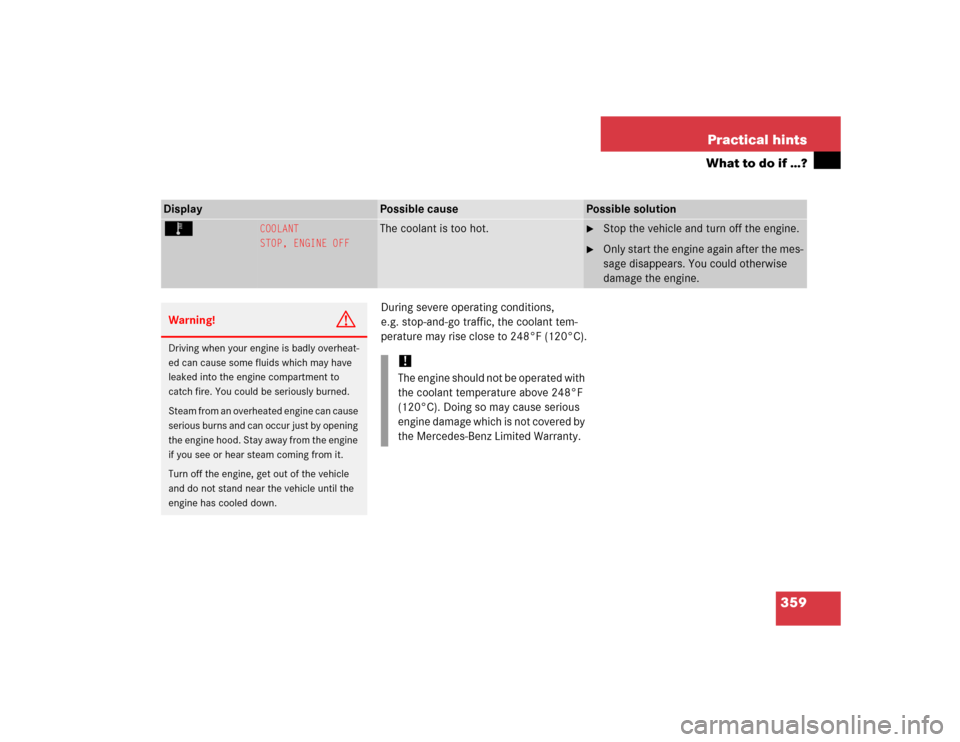Page 287 of 474

285 Operation
At the gas station
Windshield washer system and head-
lamp cleaning system*
For more information on refilling the wash-
er reservoir, see “Windshield washer sys-
tem and headlamp cleaning system*”
(�page 295).
Coolant
For more information on coolant, see
“Coolant level” (
�page 292) and see “Fu-
els, coolants, lubricants, etc.”
(
�page 429).Brake fluid
For information on brake fluid, see “Brake
fluid” (
�page 431)Engine oil level
For more information on engine oil, see
“Engine oil” (
�page 287).
Vehicle lighting
Check function and cleanliness. For more
information on replacing light bulbs, see
“Replacing bulbs” (
�page 389).
For more information, see “Switching on
headlamps” (
�page 50).
Tire inflation pressure
For information on tire inflation pressure,
see “Checking tire inflation pressure”
(
�page 307).
!If you find that the brake fluid in the
brake fluid reservoir has fallen to the
minimum mark or below, have the
brake system checked for brake pad
thickness and leaks immediately.
Notify an authorized Mercedes-Benz
Center immediately. Do not add brake
fluid as this will not solve the problem.
For more information, see “Practical
hints” (
�page 339).
Page 289 of 474

287 Operation
Engine compartment
Closing�
Let the hood drop from a height of ap-
proximately 1 ft. (30 cm).
The hood will lock audibly.
�
Check to make sure the hood is fully
closed.
If you can raise the hood at a point
above the headlamps, then it is not
properly closed. Open it again and let it
drop with somewhat greater force.
Engine oil
The amount of oil your engine needs will
depend on a number of factors, including
driving style. Higher oil consumption can
occur when�
the vehicle is new
�
the vehicle is driven frequently at
higher engine speeds
Engine oil consumption checks should only
be made after the vehicle break-in period.
Warning!
G
If you see flames or smoke coming from the
engine compartment, or if the coolant tem-
perature gauge indicates that the engine is
overheated, do not open the hood. Move
away from vehicle and do not open the hood
until the engine has cooled down. If neces-
sary, call the fire department.Warning!
G
The engine is equipped with a transistorized
ignition system. Because of the high voltage
it is dangerous to touch any components (ig-
nition coils, spark plug sockets, diagnostic
socket) of the ignition system�
with the engine running
�
while starting the engine
�
if ignition is “on” and the engine is
cranked manually
Warning!
G
Be careful that you do not close the hood on
anyone.
iDo not use any special lubricant addi-
tives, as these may damage the drive
assemblies. Using special additives not
approved by Mercedes-Benz may
cause damage not covered by the
Mercedes-Benz Limited Warranty.
More information on this subject is
available at any Mercedes-Benz
Center.
Page 294 of 474

292 OperationEngine compartmentBe careful not to spill any oil when adding.
Avoid environmental damage caused by oil
entering the ground or water.�
Screw filler cap1 back on filler neck.
For more information on engine, see the
“Technical data” section (
�page 429) and
(
�page 431).
Transmission fluid level
The transmission fluid level does not need
to be checked. If you notice transmission
fluid loss or gear shifting malfunctions,
have an authorized Mercedes-Benz Center
check the automatic transmission.Active Body Control* (ABC*) fluid level
Regular fluid level check is not required. If
you notice fluid leaks or malfunction mes-
sages in the multifunction display, have an
authorized Mercedes-Benz Center check
the ABC-system.
Coolant level
The engine coolant is a mixture of water
and anticorrosion/antifreeze.
When checking the coolant level, �
the vehicle must be parked on level
ground, and
�
the engine must be cool.
!Excess oil must be siphoned or drained
off. It could cause damage to the en-
gine and catalytic converter not cov-
ered by the Mercedes-Benz Limited
Warranty.
��
Page 295 of 474

293 Operation
Engine compartment
The coolant expansion tank is located on
the passenger side of the engine compart-
ment.
1Coolant expansion tank�
Using a rag, turn the cap slowly approx-
imately one half turn to the left to re-
lease any excess pressure.
�
Continue turning the cap to the left and
remove it.The coolant level is correct if the level
�
for cold coolant: reaches the black top
part of the reservoir
�
for warm coolant: is approximately
0.6 in (1.5 cm) higher
�
Add coolant as required.
�
Replace and tighten cap.
For more information on coolant, see
“Coolants” (
�page 433).
Warning!
G
In order to avoid any possibly serious burns:�
Use extreme caution when opening the
hood if there are any signs of steam or
coolant leaking from the cooling system,
or if the coolant temperature gauge indi-
cates that the coolant is overheated.
�
Do not remove pressure cap on coolant
reservoir if coolant temperature is
above 158°F (70°C). Allow engine to
cool down before removing cap. The
coolant reservoir contains hot fluid and
is under pressure.
�
Using a rag, slowly open the cap approx-
imately
1/2 turn to relieve excess pres-
sure. If opened immediately, scalding
hot fluid and steam will be blown out un-
der pressure.
�
Do not spill antifreeze on hot engine
parts. Antifreeze contains ethylene gly-
col which may burn if it comes into con-
tact with hot engine parts.
!S 600:
Only open the cap on coolant expan-
sion tank1. Never open the cap be-
tween the charge-air coolers.
Otherwise, the engine could be dam-
aged.
Page 360 of 474
358 Practical hintsWhat to do if …?Display
Possible cause
Possible solution
?
VISIT WORKSHOP
There may be a malfunction in the:�
Fuel injection system
�
Ignition system
�
Exhaust system
�
Fuel system
�
Visit an authorized Mercedes-Benz
Center as soon as possible.
B
COOLANT
CHECK LEVEL!
The coolant level is too low.
�
Add coolant (
�page 292).
�
If you have to add coolant frequently,
have the cooling system checked by an
authorized Mercedes-Benz Center.
Warning!
G
Do not spill antifreeze on hot engine parts.
Antifreeze contains ethylene glycol which
may burn if it comes into contact with hot
engine parts. You can be seriously burned.
!Do not ignore the low engine coolant
level warning. Extended driving with
the message and symbol displayed
may cause serious engine damage not
covered by the Mercedes-Benz Limited
Warranty.
Do not drive without a sufficient
amount of coolant in the cooling sys-
tem. The engine will overheat, causing
major engine damage.
Page 361 of 474

359 Practical hints
What to do if …?
During severe operating conditions,
e.g. stop-and-go traffic, the coolant tem-
perature may rise close to 248°F (120°C).
Display
Possible cause
Possible solution
Ï
COOLANT
STOP, ENGINE OFF
The coolant is too hot.
�
Stop the vehicle and turn off the engine.
�
Only start the engine again after the mes-
sage disappears. You could otherwise
damage the engine.
Warning!
G
Driving when your engine is badly overheat-
ed can cause some fluids which may have
leaked into the engine compartment to
catch fire. You could be seriously burned.
Steam from an overheated engine can cause
serious burns and can occur just by opening
the engine hood. Stay away from the engine
if you see or hear steam coming from it.
Turn off the engine, get out of the vehicle
and do not stand near the vehicle until the
engine has cooled down.
!The engine should not be operated with
the coolant temperature above 248°F
(120°C). Doing so may cause serious
engine damage which is not covered by
the Mercedes-Benz Limited Warranty.
Page 362 of 474
360 Practical hintsWhat to do if …?Display
Possible cause
Possible solution
Ï
COOLANT
STOP, ENGINE OFF
The poly-V-belt could be broken.
�
Stop immediately and check the
poly-V-belt.
If it is broken:
�
Do not continue to drive. Otherwise the
engine will overheat due to an inoperative
water pump which may result in damage
to the engine.
�
Notify an authorized Mercedes-Benz Cen-
ter.
If it is intact:
�
Restart the engine only after the message
disappears from the multifunction dis-
play. Doing so could result in serious en-
gine damage that is not covered by the
Mercedes-Benz Limited Warranty.
�
Observe the coolant temperature gauge
(�page 141).
�
Drive immediately to the nearest autho-
rized Mercedes-Benz Center. Adjust driv-
ing to be consistent with reduced braking
responsiveness.
Page 417 of 474
415 Technical data
Parts service
Warranty coverage
Identification labels
Layout of poly-V-belt drive
Engine
Rims and tires
Electrical system
Main dimensions and weights
Fuels, coolants, lubricants, etc.